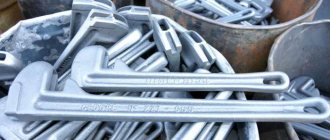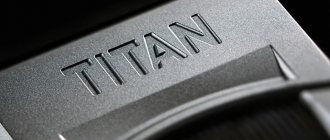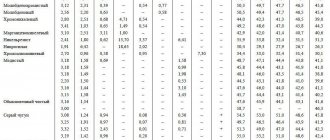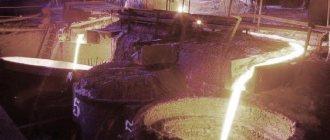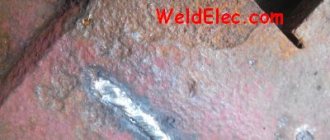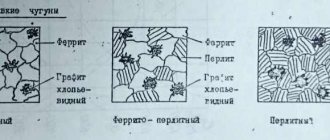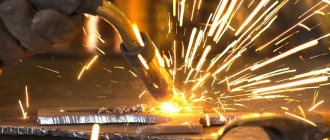Machining cast iron
Features of processing cast iron on machines Due to the presence of graphite in the structure, it is easily processed by cutting Graphite allows you to obtain short, loose chips
Features of processing cast iron on machine tools Due to the presence of graphite in the structure, it is easy to process by cutting. Graphite allows you to obtain short, loose chips _ and improves lubrication of the cutting edge. For machining cast iron, tools with a negative or slightly positive rake angle are mainly used. Coated tools have significantly greater durability due to the predominance of abrasive wear during processing. In most cases, machining can be done without coolant. The main difficulties during processing are uneven allowance on castings, the presence of casting crust and sand inclusions. 21 General Information When threading duplex and high alloy stainless steels, use the lower end of the recommended ranges. Use mineral oil whenever possible; if you have to use an emulsion, its concentration should be at least 8%. The first choice when machining stainless steel is coated tools because... it better prevents the formation of growth. Do not use worn tools, because this increases the hardening of the material during processing and leads to tool breakage. Machining of cast iron Cast irons are of three different types according to their structure: Ferritic - easy-to-work cast iron with low strength and hardness less than HB 150. At low cutting speeds it can form a built-up edge on the cutting edge. Ferritic-pearlitic - cast iron with a hardness from HB 150 to 290 units, strength can vary from low to high. Pearlitic - the strength of such cast iron depends on the size of the pearlite crystals. Fine-grained perlite gives cast iron high hardness and strength, while coarse-grained pearlite leads to its “smearing” on the cutting edge and the appearance of a build-up. ALLOYING ELEMENTS Cast iron is an alloy of iron, carbon and silicon with a carbon content of 2...4%, silicon 1...3%, it may also contain some amount of manganese (Mn), phosphorus (P) and sulfur (S). Depending on the form of graphite, cast irons are divided into gray cast irons, nodular cast irons, ductile and alloy cast irons. Alloying cast iron with nickel, copper, molybdenum and chromium, for example, increases its heat - and corrosion resistance, toughness and strength. Alloying elements are divided into carbide-forming and graphite-forming. Alloying significantly affects the machinability of cast iron. FIELD OF APPLICATION Various parts are made from cast iron, for example, engine cylinder blocks, pump and valve housings. As a rule, cast iron is used where it is necessary to obtain a part of complex shape and sufficient strength. IMPORTANT INFORMATION ABOUT PROCESSING CAST IRON Most cast irons, bulk
Cast iron technology
Producing cast iron is a very material-intensive process that requires significant costs. It takes about 550 kilograms of coke and 900 liters of water to produce one ton of the alloy. Ore costs depend on the iron content in it. Usually, raw materials with a mass fraction of the element of at least 70% are used, since processing poorer ores is not economically justified. Such raw materials first undergo an enrichment procedure, and only then are sent for smelting. Iron production takes place in blast furnaces. Only about 2% of all material produced in the world is smelted in an electric furnace.
The technological process consists of several interconnected stages. At the first stage, ore is loaded into the blast furnace, which contains the so-called magnetic iron ore (a compound of divalent and trivalent iron oxides). Ores containing hydrous iron oxide or its salts can also be used as raw materials. Along with the raw materials, coking coals are loaded into the furnace, which are designed to create and maintain high temperatures. In addition, their combustion products take part in chemical reactions as iron reducers.
Additionally, flux is supplied to the furnace, which acts as a catalyst and helps the rocks melt faster, thereby releasing iron. It is worth noting that before entering the blast furnace, the ore undergoes special pre-treatment. They are crushed using a crushing plant, since small particles will melt faster. It is then washed to remove all unnecessary elements that do not contain metal. After this, the dried raw materials are fired in special ovens, which removes sulfur and other foreign elements from the compounds.
When the blast furnace is loaded and ready for operation, the second stage of production begins. After the burners start, the coke begins to heat the raw material, releasing carbon, which, passing through the air, reacts with oxygen and forms an oxide. This oxide is actively involved in the reduction of iron from compounds found in the ore. Moreover, the more gas there is in the furnace, the weaker the chemical reaction proceeds. After reaching a certain proportion, it stops altogether. Excess gases are used as fuel to maintain the temperature in the furnace. This approach has several positive aspects. Firstly, the cost of fossil fuels is reduced, which somewhat reduces the cost of production. And, secondly, combustion products are not released into the atmosphere, polluting it with harmful impurities, but continue to participate in the technological process.
Excess carbon mixes with the melt and, absorbed by iron, forms cast iron. All unmelted rock elements float to the surface and are removed from the material. The waste is called slag, which will then be used to produce other materials. After removing all excess particles, various additives are added to the melt if necessary. In this way, two types of alloys are produced: pig iron and cast iron.
Table 2 - Densities of steels, cast irons and some non-ferrous alloys
| Alloy grade | Density, g/cm3 |
| Density of some structural steels | |
| 10 | 7,85 |
| 60 | 7,8 |
| 30ХГС | 7,85 |
| 45X | 7,82 |
| Density of some tool steels | |
| U8 | 7,84 |
| R9K10 | 8,3 |
| X12M | 7,7 |
| Density of cast iron alloys | |
| SCH10 | 6,8 |
| SCH35 | 7,4 |
| CHVG30 | 7,0 |
| Density of stainless and corrosion-resistant steels | |
| 08Х18Н10 | 7,9 |
| 08Х13 | 7,76 |
| 20Х13 | 7,67 |
| 95Х18 | 7,75 |
| Density of some aluminum alloys | |
| AL6 | 2,75 |
| AK12 | 2,65 |
| AK7ch | 2,66 |
| D16 | 2,77 |
| AK4-1 | 2,8 |
| Density of bronze alloys | |
| BrO10 | 8,8 |
| BrS30 | 9,54 |
| BrB2 | 8,2 |
| Density of some copper-nickel alloys | |
| VT20 | 4,45 |
| OT4 | 4,55 |
| VT1-0 | 4,5 |
Fast metal laser cutting price reduced by 15 percent.
Repair of cast iron metal guides
First of all, the specialist assesses the degree of wear of the cast iron frame elements - the curvature of the parts to be processed, their straightness. If cast iron demonstrates deviations from the required standards, in most cases they resort to mechanized methods of surface treatment (as the least expensive).
When hardening cast iron guides, it is better to use grinding - it is more accurate, ensures clean processing, and is more efficient in terms of productivity. To level unhardened elements, finishing planing is also used. The popularity of this method is explained by its high processing speed, cleanliness and geometric accuracy.
If the identified damage reaches threshold values, major repairs are carried out using overlays, and the damaged areas are filled with polymers. The areas to be treated are leveled and sanded.
Restoring the headstock and tailstock
As part of a comprehensive repair of machine tools, components that have become unusable are inspected and restored. For the front unit, a typical malfunction is wear of the clearances under the rolling bearings. To eliminate the damage, the holes are bored out and the bushings are pressed in. If flanges or special housings are used to accommodate bearings, worn parts are replaced with new ones. Next, the dimensions of the new bearing are adjusted, the performance characteristics are brought to the required passport values.
The front assembly housing is installed on the frame guides. Next, its orientation is restored. Using a mandrel, measurements are taken in the tapered hole of the spindle. The work is carried out until they are convinced that the spindle is parallel in the horizontal and vertical positions.
The tailstock is aligned with the front. The plane of the surface connecting the bridge with the body and the cast-iron frame is also restored. The technician replaces or repairs the feed screw and other elements.
Main characteristics
Cast iron is widespread and in demand in the ferrous metallurgy. It is produced by reconstituting iron ore with the support of a carbon fuel (coke). During the reduction reaction, the resulting melt receives an additional portion of carbon.
It is the volume of carbon in a free state that determines the mechanical parameters of this cast iron. One of the properties that allows this material to be used not only as a conversion metal, but also as a casting metal is its fairly high casting qualities and low shrinkage when the casting solidifies. Gray cast iron has high fluidity, and this makes it possible to cast quite complex products.
There is also a limitation on the use of products made from this cast iron - it is due to the fact that this material has low bending strength and high fragility. But on the other hand, it is distinguished by high compressive strength.
This material is also resistant to wear. This allows it to be used in units operating under high friction conditions. In such conditions, the antifriction parameters of gray cast iron have a strong impact.
A large volume of carbon reduces the density of gray cast iron, which is from 6.8 to 7.3 tons per m3.
Carbon inclusions do not allow permanent connections to be made from gray cast iron workpieces by welding. But, nevertheless, welding technologies have been developed and used, which can be carried out subject to a number of conditions. This set includes preheating of workpieces and the use of specialized electrodes with a high carbon content. Smooth cooling of the seam, this is necessary to remove stress in the weld. But in any case, its structure is noticeably different from the main material.
Main characteristics
Cast iron is widespread and in demand in the ferrous metallurgy. It is produced by reconstituting iron ore with the support of a carbon fuel (coke). During the reduction reaction, the resulting melt receives an additional portion of carbon.
It is the volume of carbon in a free state that determines the mechanical parameters of this cast iron. One of the properties that allows this material to be used not only as a conversion metal, but also as a casting metal is its fairly high casting qualities and low shrinkage when the casting solidifies. Gray cast iron has high fluidity, and this makes it possible to cast quite complex products.
There is also a limitation on the use of products made from this cast iron - it is due to the fact that this material has low bending strength and high fragility. But on the other hand, it is distinguished by high compressive strength.
This material is also resistant to wear. This allows it to be used in units operating under high friction conditions. In such conditions, the antifriction parameters of gray cast iron have a strong impact.
A large volume of carbon reduces the density of gray cast iron, which is from 6.8 to 7.3 tons per m3.
Carbon inclusions do not allow permanent connections to be made from gray cast iron workpieces by welding. But, nevertheless, welding technologies have been developed and used, which can be carried out subject to a number of conditions. This set includes preheating of workpieces and the use of specialized electrodes with a high carbon content. Smooth cooling of the seam, this is necessary to remove stress in the weld. But in any case, its structure is noticeably different from the main material.
Repair of cast iron frame
The most significant and massive part of a lathe is the cast iron bed. Frames made of cast iron are practically not subject to corrosion, deformation and other types of wear. During the repair, cracks or chips that arose as a result of impacts and other influences that caused damage to the cast iron bases of the bed are eliminated. They also carry out anti-corrosion treatment of surfaces - remove old paint, rust, putty, prime, paint. This ensures the cast iron frame is resistant to aggressive environmental influences.
Mechanical Features
Tensile strength
The compressive strength of cast iron depends on the structure of the material itself. The components of the structure gain their strength along with an increase in the level of dispersion. The tensile strength is strongly influenced by the number, size, distribution and formagraphite inclusions. The tensile strength decreases by a noticeable amount if the graphite inclusions are arranged in the form of a chain. This arrangement reduces the cohesion of the metal mass. The tensile strength reaches its maximum value when the graphite takes on a spheroidal shape. This form is obtained without the influence of temperature, but when cerium and magnesium are included in the cast iron mass.
- When the melting temperature increases to 400ºС, the tensile strength does not change.
- If the temperature rises above this value, the tensile strength decreases.
- Note that at temperatures from 100 to 200ºС, the tensile strength can decrease by 10-15%.
Plastic
The ductility of cast iron largely depends on the shape of the graphite, and also depends on the structure of the metal mass. If graphite inclusions have a spheroidal shape, then the percentage of elongation can reach 30.
- In ordinary gray cast iron, the elongation reaches only a tenth.
- In annealed gray cast iron, the elongation is 1.5%.
Elasticity depends on the shape of the graphite. If the graphite inclusions did not change, and the temperature increased, then the elasticity remains at the same value.
The elastic modulus is considered a conditional value, since it has a relative value and directly depends on the presence of graphite inclusions. The elastic modulus decreases if the number of graphite inclusions increases. Also, the elastic modulus increases if the shape of the inclusions is distant from the globular shape.
Impact strength
This indicator reflects the dynamic properties of the material. The impact strength of cast iron increases:
- when the shape of graphite inclusions is close to spherical;
- when the ferrite content increases;
- when the graphite content decreases.
Endurance limit
The endurance limit of cast iron becomes greater when the frequency of loading increases and the tensile strength becomes greater.
Repair of caliper made of cast iron metal
The most difficult procedures include work to restore the functionality of the carriage, work on the transverse, rotary and upper slides of the machine.
The first step is to align the cross feed guides. They must be positioned exactly relative to each other, as well as relative to the cross feed screw. Additionally, the perpendicular to the longitudinal guides is checked.
Overlays made of polymeric materials and textolite are widely used. In terms of work efficiency, polymer filling of guides demonstrates good results.
In some cases, it is necessary to align the location of the holes of the units that determine the functioning of the drive shaft, screw and speed shift shaft. Changes in the position of the axes are restored by attaching new linings. The guides are also polished and carriage covers are installed. If the axes are significantly displaced, the malfunction can be eliminated by reinstalling the gearbox of cast iron machines.
